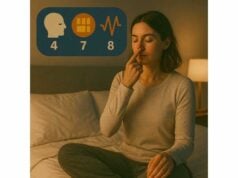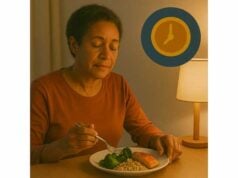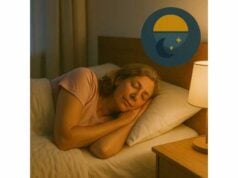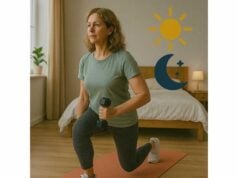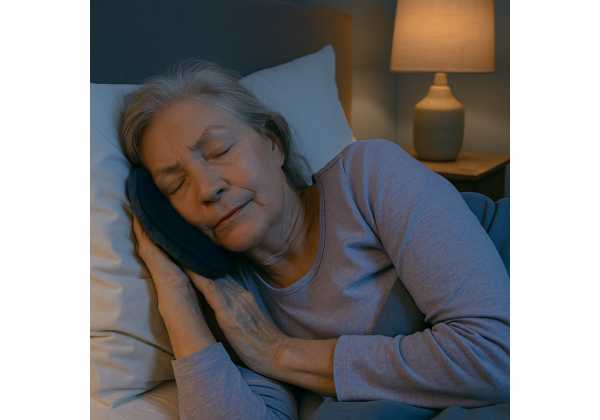
Aging changes the scaffolding of sleep—its timing, depth, and the way your brain and body use the night to repair. Many people notice lighter, more fragmented nights in midlife, and they worry something is wrong. In most cases, the architecture of sleep is shifting in predictable ways. The goal is not to chase perfect nights but to support the system: protect deep (N3) and rapid eye movement (REM) sleep, and track recovery with a few reliable metrics. This guide explains how sleep architecture works, what changes with age, and the levers that actually move the needle—temperature, light, timing, and daily behaviors. For a broader context on how nightly rest fits into healthy longevity, see our pillar page on sleep, stress, and recovery for healthspan. Then come back here to set practical, measurable targets you can sustain.
Table of Contents
- Sleep Architecture 101: Stages and Cycles Explained
- How Sleep Changes with Age and What Is Normal
- Deep Sleep Targets: Temperature, Light, and Timing
- REM Sleep and Mood: Avoiding Late Night Disruptors
- Recovery Metrics: HRV, Resting Heart Rate, and Readiness
- Common Disruptors: Pain, Alcohol, Caffeine, and Stress
- When to Get a Sleep Evaluation for Persistent Issues
Sleep Architecture 101: Stages and Cycles Explained
Sleep is not a single state. It is a repeating pattern of non-REM (NREM) and REM stages arranged in 90-minute (give or take) cycles across the night. Each cycle typically includes:
- N1 (lightest sleep): The transition from wakefulness—brief, easily disrupted.
- N2 (light sleep): Spindles and K-complexes dominate; sensory processing turns down; memory traces begin consolidating.
- N3 (deep or slow-wave sleep): Large, synchronized brain waves (delta). Growth hormone peaks, glymphatic clearance increases, immune signaling resets, and tissues repair.
- REM (dream-rich sleep): Brain activity becomes more wake-like; muscle tone is inhibited; emotional processing and memory integration accelerate.
The distribution evolves through the night: deep sleep loads the first third, REM concentrates in the final third. That’s why late bedtimes and early alarms selectively clip REM, while very short nights often protect deep sleep at the expense of REM’s mood and memory benefits.
Think of sleep pressure and circadian timing as a two-engine plane. Homeostatic sleep pressure builds during wakefulness (driven in part by adenosine), pushing you toward sleep. Circadian timing (your body clock) tells the brain when to release melatonin and shift temperature and hormones into a “sleep window.” When these engines align—adequate prior wake time and a clock-consistent bedtime—sleep onset is easy and the architecture is robust. When they misalign (naps too late, bright evening light, irregular schedules), sleep can fragment even if you spend enough hours in bed.
A helpful way to put this into practice:
- Protect cycles, not just hours. Aim for a consistent sleep window that allows 4–6 cycles (roughly 7–9 hours in bed, assuming normal sleep efficiency).
- Front-load deep sleep. Keep the room cool at the start of the night and avoid vigorous exercise in the 2–3 hours before bed to make it easier to descend into N3.
- Guard the REM peak. Maintain a stable wake time to avoid cutting off the final cycles. If you shift your bedtime later, shift your wake time too, so the last third of the night survives.
- Expect variability. One irregular night is rarely problematic; patterns over weeks matter more.
Understanding this scaffold helps you target interventions—temperature, light, caffeine timing—at the parts of the night they influence most.
How Sleep Changes with Age and What Is Normal
Sleep becomes lighter and more fragmented from midlife onward. Deep sleep (N3) gradually declines, awakenings become more frequent, and the circadian rhythm can shift earlier (“advanced sleep phase”), especially in older adults. These changes are common and do not automatically mean you have a sleep disorder. The most important distinction is between normal age-related changes and clinically significant symptoms (daytime sleepiness, impaired function, snoring with pauses, restless legs, or persistent insomnia).
What to expect across the decades:
- 30s–40s: Subtle drop in N3, more evening alertness if exposed to bright light or screens; social jet lag often rises due to work/family demands.
- 50s–60s: More awakenings; increased risk of insomnia symptoms; hot flashes or night sweats around menopause; increased snoring and risk for breathing-related events.
- 70s+: Lighter sleep with shorter total time, earlier wake times, and more nocturia. Daytime naps become more common—use them strategically (20–30 minutes, early afternoon).
Normal does not mean inevitable decline. You can retain high-quality sleep by supporting daytime light exposure, regular activity, and stable routines. In fact, tighter sleep regularity (consistent bed and wake times, even on weekends) often yields clearer benefits than chasing an exact duration. If you do nap, cap it and schedule it; late, long naps fragment the following night.
Two signs your sleep remains healthy despite lighter nights:
- Daytime function is intact. You feel alert enough to work, drive, and focus.
- Latency and maintenance are reasonable. Falling asleep within ~15–25 minutes and having a few brief awakenings is typical.
When in doubt, audit the basics for two weeks: morning light, movement, mealtime timing, evening light reduction, and caffeine cutoffs. Many “aging” complaints improve once these are in place. For practical, age-aware tweaks by decade, see our checklist at sleep across the decades.
Deep Sleep Targets: Temperature, Light, and Timing
Deep sleep is metabolically unique: core temperature drops, slow waves synchronize neural activity, and physical recovery is prioritized. Three levers predictably influence N3.
1) Temperature: create a cool-to-cozy night.
Your brain initiates sleep by dumping heat through distal skin (hands, feet). Help it along:
- Bedroom: Most adults sleep best when the ambient room is cool and stable. If your nights run hot, set the room so you feel slightly cool at lights-out, then add breathable layers you can adjust without fully waking.
- Bedding microclimate: Choose breathable fabrics (cotton, linen, TENCEL®) and avoid heat-trapping foam layers unless they are actively cooled. A warm shower 60–90 minutes before bed can trigger the post-bath cooling that eases sleep onset.
- Air movement and humidity: A quiet fan increases convective heat loss; keep relative humidity in a comfortable range (about 40–55%) to reduce mucosal dryness and nasal resistance.
2) Light: anchor the clock, dim the evening.
Melatonin is light sensitive, especially to short wavelengths. Practical targets:
- Daytime: Get bright outdoor light soon after waking; aim for at least 30–60 minutes outdoors or near a large window in the first half of the day.
- Evening (3 hours before bed): Dim overheads, prefer lamps at eye level, and shift to warmer, lower melanopic light. Use device settings that lower blue-enriched output, but don’t rely on them alone—reduce total brightness and viewing distance.
- Night: Keep the sleep environment as dark as possible. If you need a night light for safety, use low, warm light and place it below eye level to minimize circadian impact.
3) Timing: ride sleep pressure.
Deep sleep clusters in the first third of the night. To protect it:
- Hold a stable bedtime within a 30–60 minute window.
- Avoid vigorous exercise in the last 2–3 hours if it keeps you alert and hot; schedule training earlier when deep sleep is your target.
- Caffeine cutoffs: If you are sensitive, avoid caffeine after midday. Even for fast metabolizers, large doses late in the day can reduce N3. Small, earlier doses (e.g., 50–100 mg pre-noon) are generally safer.
A staged plan to increase N3:
- Week 1: Fix wake time and morning light; set a single bedtime alarm to start winding down.
- Week 2: Optimize temperature and bedding; dim the last three hours; move late exercise earlier.
- Week 3: Make caffeine a morning-only habit on weekdays; observe changes in deep sleep on your wearable (look for trend lines, not single-night noise).
- Week 4: If still low, add a pre-sleep relaxation protocol (10–15 minutes nasal breathing, or a brief body scan) and review medications for stimulatory effects.
If you want a deeper dive on environmental setup, see simple circadian wins.
REM Sleep and Mood: Avoiding Late Night Disruptors
REM sleep is where emotional memory processing, threat learning “defusion,” and creative integration flourish. Because REM concentrates in the final third of the night, the most common REM saboteurs are late-night behaviors that erupt into the early morning window.
Alcohol is the most underestimated one-two punch. It can shorten sleep latency (you fall asleep faster) but fragments the second half of the night and reduces REM. The result: you wake early, feel unrefreshed, and your mood is brittle the next day. If you choose to drink, protect REM by front-loading intake with your evening meal, limiting total ethanol, and cutting off at least 3–4 hours before lights-out. Hydrate, add slow-digesting carbs at dinner, and keep the room cooler to counter vasodilation heat.
Caffeine lingers longer than you think. Its half-life varies widely, but large late doses remain active into the final cycles where REM should peak. Keep high doses (≥300–400 mg) out of the last 8–12 hours before bed. If you plan a very early bedtime, move your last cup earlier.
Late meals can pull blood to the gut and raise core temperature; both affect REM-rich sleep. Aim for a 2–3 hour buffer between the final full meal and bedtime. A small, balanced snack (e.g., yogurt with berries, or a banana and a spoon of nut butter) is fine if you otherwise wake hungry at 3 a.m.
Mental activation also matters. Doomscrolling, high-stakes emails, or intense shows right before bed spill cognitive and emotional arousal into REM-heavy hours. Replace with a low-stimulus wind-down: a paper book, a short stretch routine, or a 10-minute breath sequence.
A quick “REM-safe” evening template:
- T-3 hours: Dim lights; finish main meal; no vigorous workouts.
- T-2 hours: Devices to low brightness; stop alcohol; review tomorrow’s top 3 tasks to offload rumination.
- T-1 hour: Shower or bath; light reading or music; optional calming tea (e.g., caffeine-free).
- Lights-out: Room dark, cool, quiet; eye mask and earplugs as needed.
For a concise guide on timing alcohol, caffeine, and meals, see timing rules that protect sleep.
Recovery Metrics: HRV, Resting Heart Rate, and Readiness
Wearables have made nightly recovery visible, but interpretation—especially in midlife—requires nuance. The two most useful trend metrics are nocturnal resting heart rate (RHR) and heart rate variability (HRV).
Resting Heart Rate (RHR):
- Direction: Lower is usually better—within your personal range.
- Pattern: A healthy sleep night shows a “reverse-J” curve: RHR starts higher at lights-out, declines through the first half (deep sleep), and plateaus low overnight.
- Red flags: A flat, elevated profile suggests heat, late meals/alcohol, illness, or accumulated stress. A single blip is noise; 3–5 nights in a row is a signal.
Heart Rate Variability (HRV):
- What it reflects: Beat-to-beat variation influenced by autonomic balance. Higher overnight HRV often indicates better parasympathetic tone and recovery.
- Age and sex: HRV trends down with age and differs by sex and training status. Compare you to you over weeks, not to population charts.
- Sleep link: Deep, consolidated sleep and lower nocturnal temperature often correlate with higher HRV; sleep deprivation and circadian misalignment lower it.
How to use them—practically:
- Aim for trend stability. Look at 28-day rolling averages. Improvements from temperature control, earlier dinners, or reduced alcohol show up as lower average RHR and higher average HRV, especially mid-night.
- Time your training. If your RHR spiked and HRV dipped after a hard evening session, shift intensity earlier or separate aerobic and resistance days.
- Control confounders. Fever, antihistamines, beta-blockers, dehydration, and menstrual phase can change these metrics without reflecting “recovery.”
Setting targets:
- RHR: Seek a gradual downward trend relative to your baseline and a smooth overnight decline. If your lowest point shifts later into the night, it often signals late meals or alcohol.
- HRV: Prioritize consistency over peaks. If breathwork or a short pre-sleep stretch nudges HRV up 5–10 ms on average across a month, that’s meaningful.
- Sleep staging (from wearables): Treat as directional, not diagnostic. Devices vary in staging accuracy. Use stage trends (e.g., longer deep sleep after cooler nights) rather than absolute minutes to guide changes.
For a deeper understanding of what HRV can and cannot tell you about longevity and recovery, see HRV fundamentals.
Common Disruptors: Pain, Alcohol, Caffeine, and Stress
Pain and inflammation are frequent culprits in midlife sleep fragmentation. Joint pain, back discomfort, and nocturnal cramps pull the brain toward lighter stages. Tactics that help:
- Positioning: Use a thin pillow between the knees for side-sleepers or under the knees for back-sleepers to flatten lumbar strain.
- Micro-heat: A local heat pack for 10–20 minutes before bed can reduce muscle guarding without raising whole-body heat.
- Anti-inflammatory routine: Consistent daytime movement, gentle mobility work, and a nutrient-dense diet support lower night-time arousal.
Alcohol fragments sleep, particularly the second half of the night. Treat it like a performance variable: if you drink, front-load with food, hydrate, and expect a higher RHR and lower HRV before the body rebalances.
Caffeine interacts with timing and dose. Practical rules:
- Keep daily intake ≤200–300 mg if you’re sensitive or sleep-constrained.
- Set a personal cutoff—start with 7–9 hours before planned bedtime; for larger doses (≥300–400 mg), extend to 10–12 hours.
- Watch for “stealth” sources (pre-workouts, dark chocolate, some pain relievers).
Stress and rumination often show up as difficulty re-entering sleep after a 2–3 a.m. wake. A simple, repeatable wake-back-to-bed script helps:
- Stay in low light and avoid clocks.
- Sit upright and practice a 4-7-8 or box breathing cycle for 3–5 minutes.
- Do a brief body scan or read a few pages of a low-stakes book until sleepiness returns.
- Return to bed and repeat the breath once.
If pain is a primary driver or wakes are frequent and prolonged, it’s worth addressing comfort directly—mattress age and firmness, pillow height, and nighttime bathroom trips (reduce late fluids, speak with your clinician about diuretics or nocturia management). For more on aligning comfort and inflammation, see getting comfortable with pain management at night.
When to Get a Sleep Evaluation for Persistent Issues
Self-care handles most sleep complaints. Still, certain patterns warrant evaluation because they carry medical risks or respond best to targeted treatment.
Seek a professional assessment if you notice:
- Loud snoring with witnessed pauses, gasping, morning headaches, or daytime sleepiness (risk for obstructive sleep apnea).
- Unrefreshing sleep despite enough time in bed, plus high blood pressure, atrial fibrillation, insulin resistance, or weight gain—all common co-travelers with breathing-related sleep disorders.
- Leg discomfort or urges to move that worsen at night and improve with movement (possible restless legs syndrome), or repetitive kicks during sleep reported by a bed partner.
- Dream-enactment behaviors (talking, punching, falling out of bed) suggesting REM behavior disorder.
- Persistent insomnia (trouble falling or staying asleep) at least 3 nights/week for 3 months, especially if it impairs daytime function—CBT-I is first-line and highly effective.
- Excessive daytime sleepiness that affects driving safety or work—even without snoring.
- Sudden shifts in sleep timing (very late or very early) that create social or occupational impairment.
What to expect from evaluation:
- A sleep-focused history and physical exam; review of medications, alcohol/caffeine timing, and mental health symptoms.
- Home sleep apnea testing if apnea is suspected; in-lab polysomnography if more complex conditions are likely (e.g., comorbid insomnia and apnea, limb movement disorders, parasomnias).
- A personalized plan that may include CBT-I, CPAP or oral appliance therapy for apnea, iron studies and treatment for restless legs, and tailored circadian or behavioral strategies.
How to prepare:
- Keep a 2-week sleep diary with bedtime, wake time, naps, alcohol/caffeine timing, exercise, and any awakenings.
- List medications and supplements with doses and timing.
- Note specific goals (e.g., “reduce 3 a.m. wakes,” “stop dozing at the wheel,” “lower blood pressure”).
Sleep medicine is highly actionable. The right diagnosis and a few focused changes often restore both sleep quality and daytime energy in weeks.
References
- Recommendations for daytime, evening, and nighttime indoor light exposure to best support physiology, sleep, and wakefulness in healthy adults 2022 (Consensus/Guideline)
- Dose and timing effects of caffeine on subsequent sleep: a randomized clinical crossover trial 2024 (RCT)
- Nighttime Ambient Temperature and Sleep in Community-Dwelling Older Adults 2023 (Observational Study)
- Effects of sleep deprivation on heart rate variability 2025 (Systematic Review and Meta-analysis)
- Recommendation: Obstructive Sleep Apnea in Adults: Screening | United States Preventive Services Taskforce 2022 (Guideline)
Disclaimer
This article is for educational purposes and does not replace personalized medical advice, diagnosis, or treatment. Always consult a qualified health professional regarding symptoms, medications, or changes to your sleep, exercise, or nutrition routines. If you experience excessive daytime sleepiness, unsafe drowsiness while driving, or symptoms of sleep apnea or other sleep disorders, seek prompt evaluation.
If you found this guide useful, please consider sharing it on Facebook, X, or your preferred platform, and follow our social channels. Your support helps us continue creating thoughtful, evidence-based resources.


